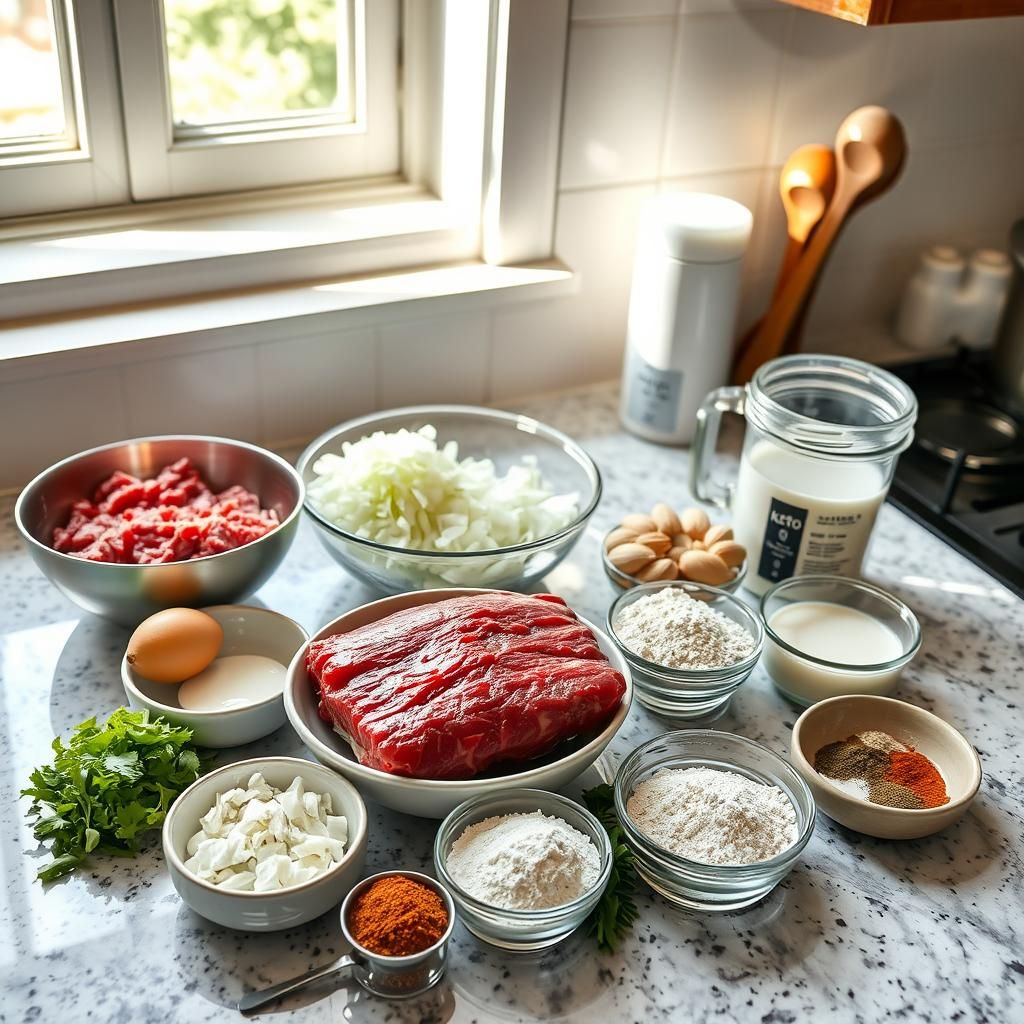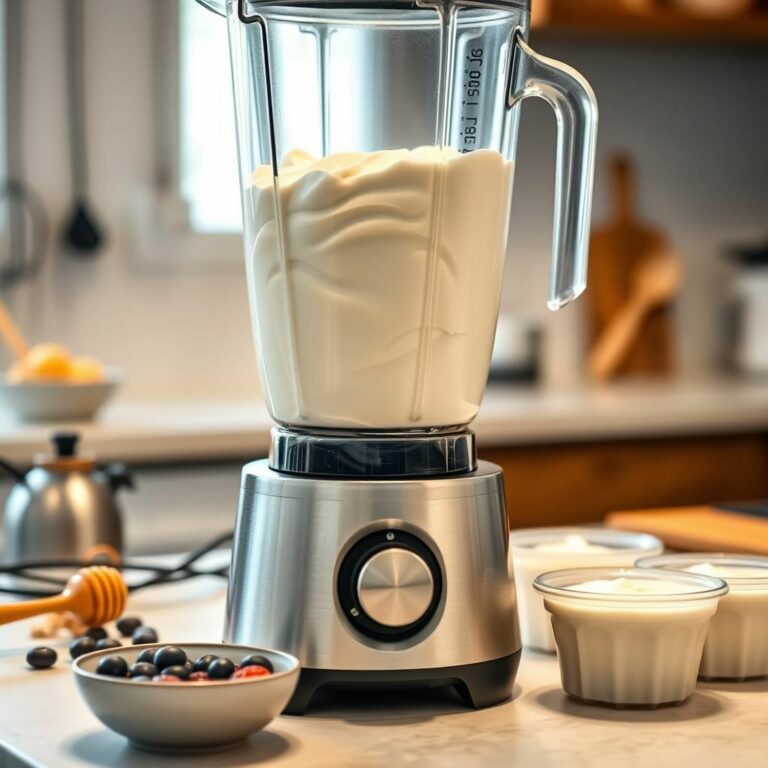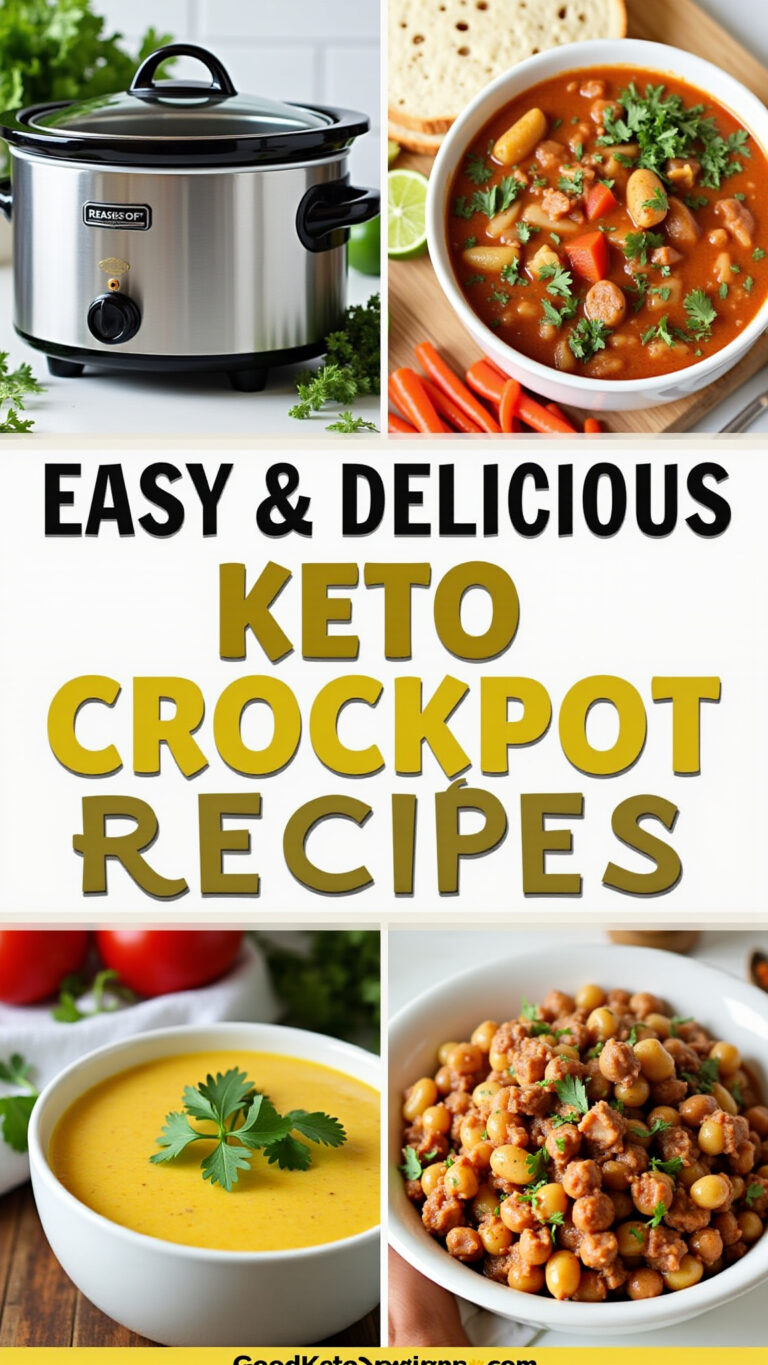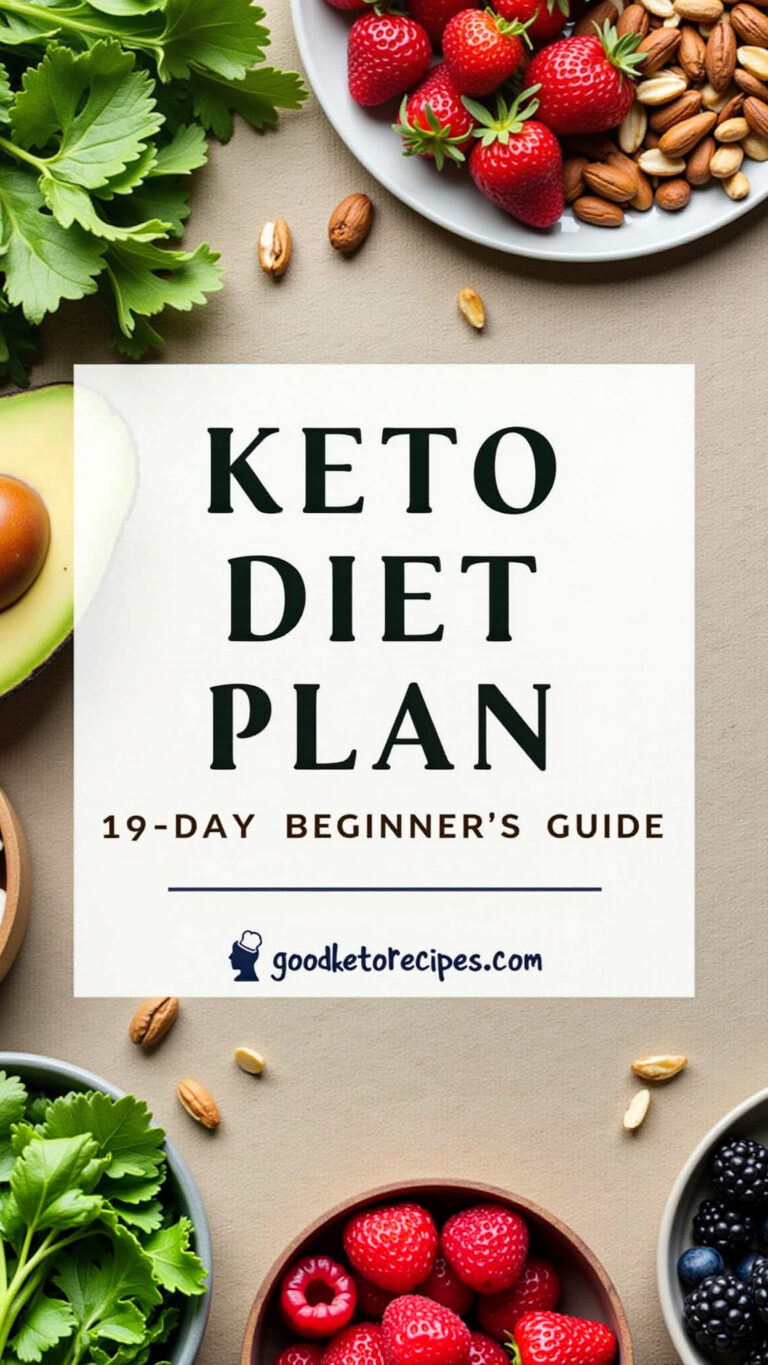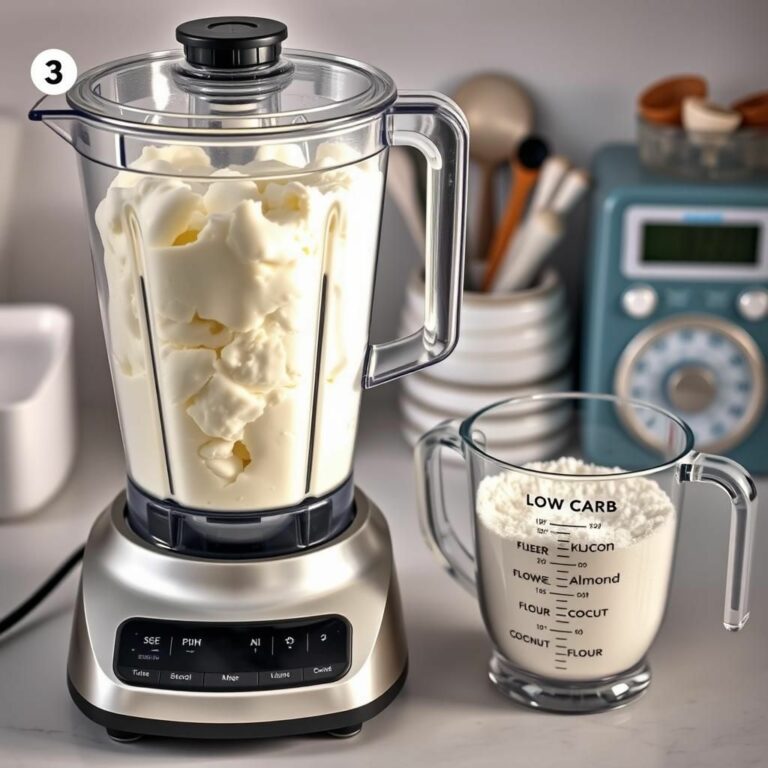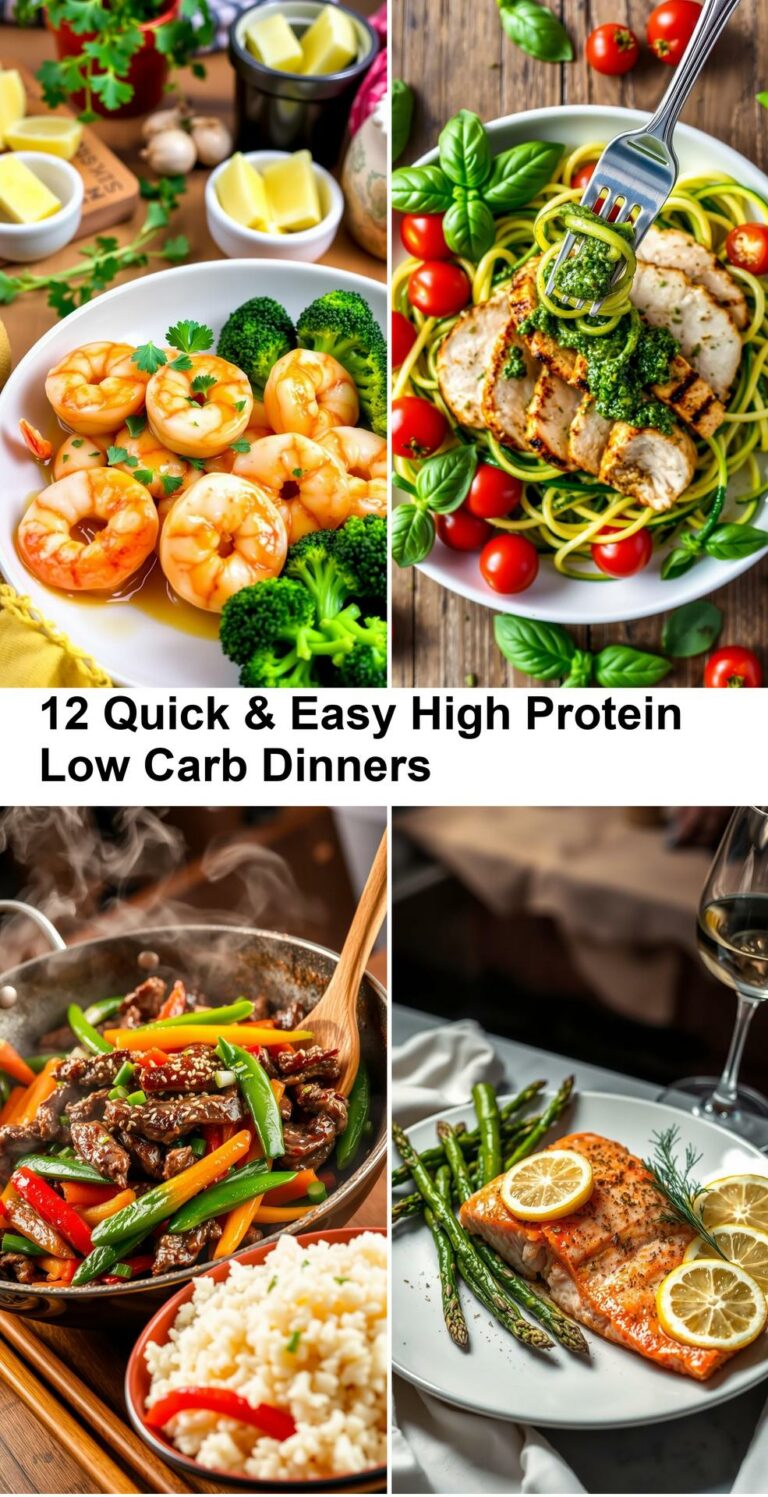Easy Keto Meatloaf: A Low-Carb Classic
Meatloaf holds a special place in the heart of comfort food. It’s a nostalgic dish, often conjuring memories of family dinners, cozy evenings, and simple, satisfying flavors. The classic combination of seasoned ground meat, bound together and baked to perfection, then topped with a tangy glaze, is undeniably appealing. However, for those following a ketogenic or low-carb lifestyle, the traditional meatloaf recipe presents a significant challenge.The primary culprits are the binders – typically breadcrumbs or crackers – and the glaze, which is almost always loaded with sugar from ketchup or brown sugar. These components push the carbohydrate count far beyond what is permissible on a strict keto diet, making traditional meatloaf off-limits for many.But the good news is, you don’t have to sacrifice this beloved classic! With a few smart substitutions and a focus on flavor, you can create a delicious, moist, and satisfying meatloaf that is perfectly aligned with a low-carb, high-fat eating plan. This “Easy Keto Meatloaf” recipe proves that comfort food can absolutely be keto-friendly, bringing all the familiar flavors and textures without the carb load. If you are looking for a complete guide to starting and maintaining a low-carb lifestyle, check out **The Keto Diet**. Or, for personalized guidance, explore **Custom Keto Diet**.This article will guide you through crafting the perfect keto meatloaf. We’ll cover why traditional recipes don’t work on keto, explore the best low-carb binders and sugar-free glaze options, provide a detailed step-by-step recipe, share tips for ensuring a moist and flavorful loaf, discuss delicious variations, and even offer advice on meal prepping and storage. Get ready to rediscover the simple pleasure of meatloaf, the keto way!
Why Keto Meatloaf? The Low-Carb Advantage
The ketogenic diet focuses on shifting your body’s metabolism from burning carbohydrates for fuel to burning fat (ketosis). This typically involves consuming very low amounts of carbs (usually 20-50 grams per day), moderate protein, and high amounts of healthy fats. Many people follow this diet for weight management, improved energy levels, mental clarity, and managing certain health conditions. For structured meal planning, consider **The Ultimate Keto Meal Plan** or a **30 DAY KETO MEAL PLAN**.Traditional meatloaf works against this goal for several key reasons:* **Carb-Heavy Binders:** Breadcrumbs, crackers, or even oatmeal are standard binders in conventional meatloaf. Their purpose is to absorb moisture, help the loaf hold its shape, and add texture. However, these are pure carbohydrates. A single slice of traditional meatloaf can easily contain 10-15 grams of net carbs or more just from the binder alone. If you miss traditional baked goods, explore **Keto Breads and Pizza recipe book** for low-carb alternatives.* **Sugary Glazes:** The iconic meatloaf glaze is often made from ketchup (high in added sugar), brown sugar, or a combination. This adds a sweet, tangy crust, but also injects a significant amount of sugar, and therefore carbs, into the dish. Even a small amount of glaze can add 5-10 grams of net carbs or more per serving.By replacing these high-carb elements with keto-friendly alternatives, we can create a meatloaf that fits seamlessly into a ketogenic or low-carb diet while retaining the essential characteristics that make it so loved. The advantages of making keto meatloaf include:* **Diet Compliance:** It allows you to enjoy a classic comfort food without getting kicked out of ketosis.* **Satiety:** High in protein and healthy fats, it’s incredibly filling and can help manage hunger.* **Family-Friendly:** Meatloaf is often a crowd-pleaser, making this keto version a great option for families where not everyone is strictly keto. It tastes so good, most people won’t even miss the carbs!* **Meal Prep Gold:** Meatloaf is fantastic for leftovers, making it an ideal candidate for weekly meal preparation. It reheats well and can be portioned out for quick, healthy meals.* **Nutrient Dense:** When made with quality ground meat and added vegetables, it’s a good source of protein, vitamins, and minerals.Our easy keto meatloaf recipe addresses the high-carb issues by utilizing low-carb binders and a sugar-free glaze, ensuring you get all the comfort without the carbohydrate guilt.
Gathering Your Ingredients
Crafting the perfect keto meatloaf starts with selecting the right ingredients. The goal is to replicate the texture and flavor of traditional meatloaf while keeping the carb count low.
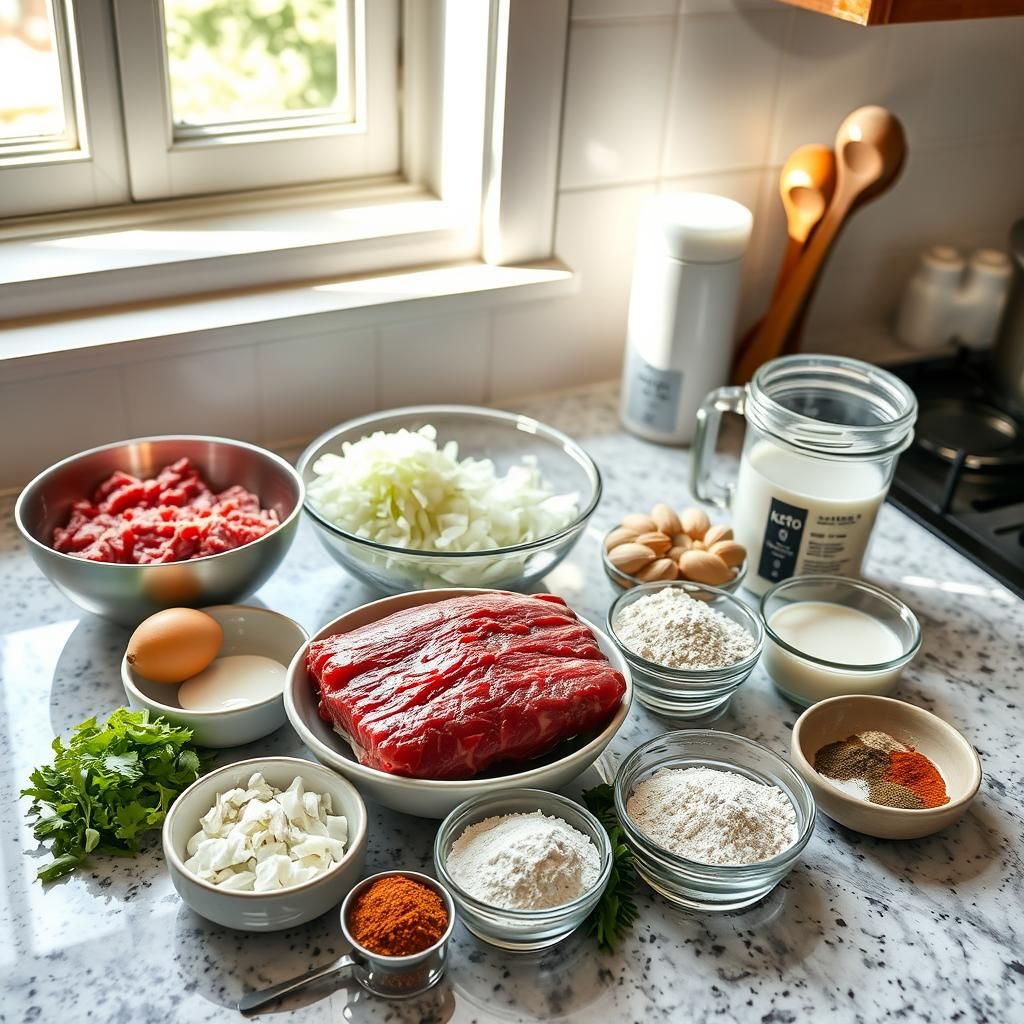
The Meat Base
The foundation of any good meatloaf is the meat.* **Ground Beef:** This is the classic choice. The fat content is important for moisture and flavor. Using 80/20 ground beef is often recommended for meatloaf because the higher fat content helps keep the loaf moist during cooking. Leaner beef (like 90/10) can result in a drier meatloaf unless extra moisture is added.* **Combinations:** For enhanced flavor and texture, consider combining ground beef with other meats: * **Beef and Pork:** A popular choice, often using a mix like 50% ground beef and 50% ground pork. Pork adds moisture and richness. * **Beef and Sausage:** Using Italian sausage (check carb content, some have fillers) can add fantastic flavor, especially if it’s a spicy variety. * **Beef and Veal:** A classic “meatloaf mix” often found at butcher shops. Veal is leaner but tender. * **Ground Turkey or Chicken:** You can make a poultry-based keto meatloaf, but these tend to be much leaner. You’ll need to be extra careful about adding moisture (like dark meat, butter, or cream) and not overcooking to prevent dryness.For this “easy” recipe focus, we’ll primarily use ground beef, but understanding these options gives you flexibility. An 80/20 ground beef is a great starting point for ease and moisture.
The Keto Binder
This is where the most significant keto swap happens. Instead of breadcrumbs, we need low-carb alternatives that can absorb some moisture and help hold the meatloaf together. The key is using just enough to bind without making the meatloaf dense or dry.* **Almond Flour:** A popular keto flour made from ground almonds. It’s relatively neutral in flavor and absorbs moisture well. Use finely ground almond flour for the best texture. It typically contains around 2-3 net carbs per 1/4 cup.* **Ground Flaxseed Meal:** Made from ground flaxseeds. It’s high in fiber and omega-3 fatty acids. When mixed with liquid, it forms a gel-like consistency that works well as a binder. It has a slightly nutty flavor. Look for golden or brown flaxseed meal. It’s very low in net carbs.* **Crushed Pork Rinds (Pork Panko):** Unseasoned, finely crushed pork rinds make an excellent breadcrumb substitute. They are zero carb and add a savory flavor and lighter texture than dense flours. You can buy them pre-crushed (“pork panko”) or crush them yourself using a food processor or rolling pin.A common ratio is about 1/4 cup of binder per pound of meat, plus an egg. We’ll provide specific quantities in the recipe, but understanding the role of these alternatives is crucial. Using a combination (e.g., a little almond flour and some crushed pork rinds) can sometimes yield the best texture.
Flavor Enhancers
Beyond the meat and binder, other ingredients build the depth of flavor typical of meatloaf.* **Aromatics:** Diced onion and garlic are standard. Sautéing them gently before adding to the meat mixture is highly recommended. This softens them, removes harshness, and pre-cooks them slightly, preventing crunchy bits in the finished meatloaf. Diced bell peppers or celery are also good additions for flavor and moisture, if desired.* **Eggs:** Eggs are essential. They act as a binder, helping to emulsify the mixture and hold everything together as it cooks. Use one large egg per pound of meat as a general guideline.* **Liquids:** A splash of liquid adds moisture. Options include: * Heavy cream or half-and-half (adds richness and moisture) * Beef or chicken broth (adds savory depth) * Unsweetened almond milk (adds moisture without much flavor impact)* **Seasoning:** Don’t be shy with salt and pepper. Other common seasonings include: * Worcestershire sauce (check for added sugar; Lea & Perrins original has minimal carbs per serving, but look for keto-specific versions if concerned) * Dijon mustard * Herbs (dried or fresh parsley, thyme, oregano, sage, rosemary) * Spices (garlic powder, onion powder, smoked paprika, a pinch of cayenne for heat)
The Keto Glaze
A traditional meatloaf glaze is usually tomato-based and sweet. We need to replicate this tangy sweetness without sugar.
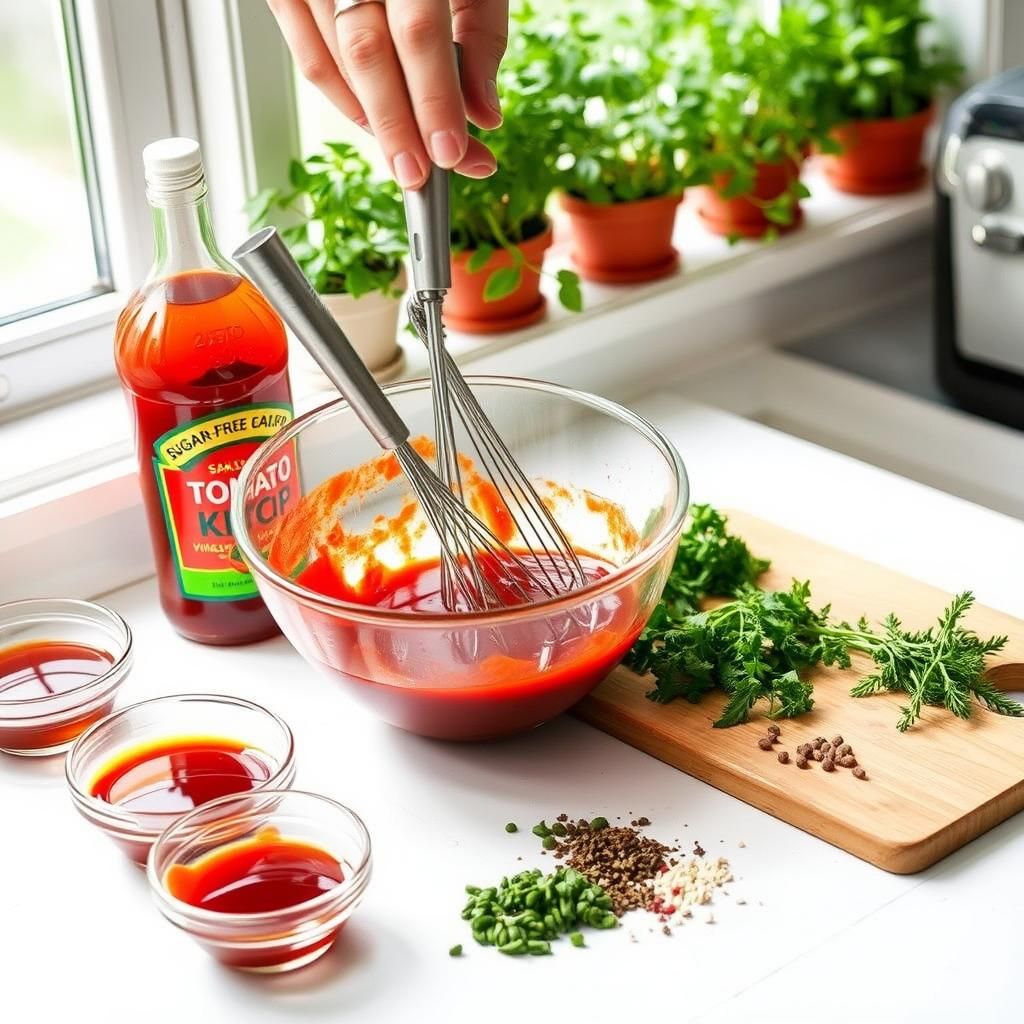
* **Sugar-Free Ketchup:** This is the easiest base. Many brands now offer sugar-free ketchup sweetened with erythritol, xylitol (be careful if you have dogs, xylitol is toxic to them), stevia, or sucralose. Ensure the net carb count is very low.* **Tomato Paste:** Adds concentrated tomato flavor and thickness without the added sugar found in ketchup.* **Vinegar:** Apple cider vinegar or white vinegar adds tanginess, balancing the sweetness.* **Sweetener:** A keto-friendly granular sweetener (like erythritol, allulose, or a blend) is needed to provide the sweetness that balances the tomato and vinegar. Adjust to your preferred level of sweetness.* **Seasoning:** A dash of mustard (Dijon or yellow), garlic powder, onion powder, salt, and pepper can enhance the glaze flavor.By combining sugar-free ketchup, tomato paste, vinegar, sweetener, and seasonings, we can create a glaze that caramelizes beautifully and provides that signature meatloaf finish without the carbs.
Step-by-Step: Crafting Your Easy Keto Meatloaf
Here is a detailed, easy-to-follow recipe for a classic Keto Meatloaf. This recipe yields about 6-8 servings.**Prep time:** 15-20 minutes**Cook time:** 50-60 minutes**Rest time:** 10 minutes**Ingredients:*** 2 lbs (approx. 900g) 80/20 ground beef* 1 medium onion, finely diced* 2 cloves garlic, minced (or 1 tsp garlic powder)* 1 large egg* 1/4 cup unsweetened almond milk, heavy cream, or beef broth* 1/4 cup keto binder (choose ONE: almond flour, finely crushed pork rinds, or ground flaxseed meal)* 1 tbsp Worcestershire sauce (ensure low sugar or keto-friendly)* 1 tsp Dijon mustard* 1 tsp dried Italian seasoning (or a mix of dried parsley, oregano, thyme)* 1/2 tsp salt* 1/4 tsp black pepper**For the Keto Glaze:*** 1/2 cup sugar-free ketchup* 1 tbsp tomato paste* 1 tbsp apple cider vinegar* 1-2 tbsp keto-friendly granular sweetener (adjust to taste)* 1 tsp Dijon mustard* Pinch of salt and pepper**Equipment:*** Large mixing bowl* Sharp knife and cutting board* Skillet (optional, for sautéing aromatics)* Loaf pan (9×5 inches) or baking sheet lined with parchment paper or foil* Instant-read meat thermometer**Instructions:**1. **Preheat and Prep:** Preheat your oven to 375°F (190°C). If using a loaf pan, lightly grease it or line it with parchment paper, leaving some overhang for easy lifting. If using a baking sheet for a freeform loaf, line it with parchment paper or foil.2. **Sauté Aromatics (Optional but Recommended):** In a small skillet over medium heat, add a little oil or butter (about 1 tsp). Add the finely diced onion and cook for 5-7 minutes until softened and translucent. Add the minced garlic and cook for another 1-2 minutes until fragrant. Allow to cool slightly. *Pro Tip: Sautéing prevents crunchy onion bits in your meatloaf and enhances their flavor.* If skipping this step, ensure your onion is *very* finely diced or even grated.3. **Prepare the Meat Mixture:** In a large mixing bowl, gently break apart the ground beef. Add the cooled sautéed onion and garlic (or the garlic powder if skipping sautéing). Add the egg, liquid (almond milk/cream/broth), selected keto binder (almond flour, pork rinds, or flax meal), Worcestershire sauce, Dijon mustard, Italian seasoning, salt, and pepper.
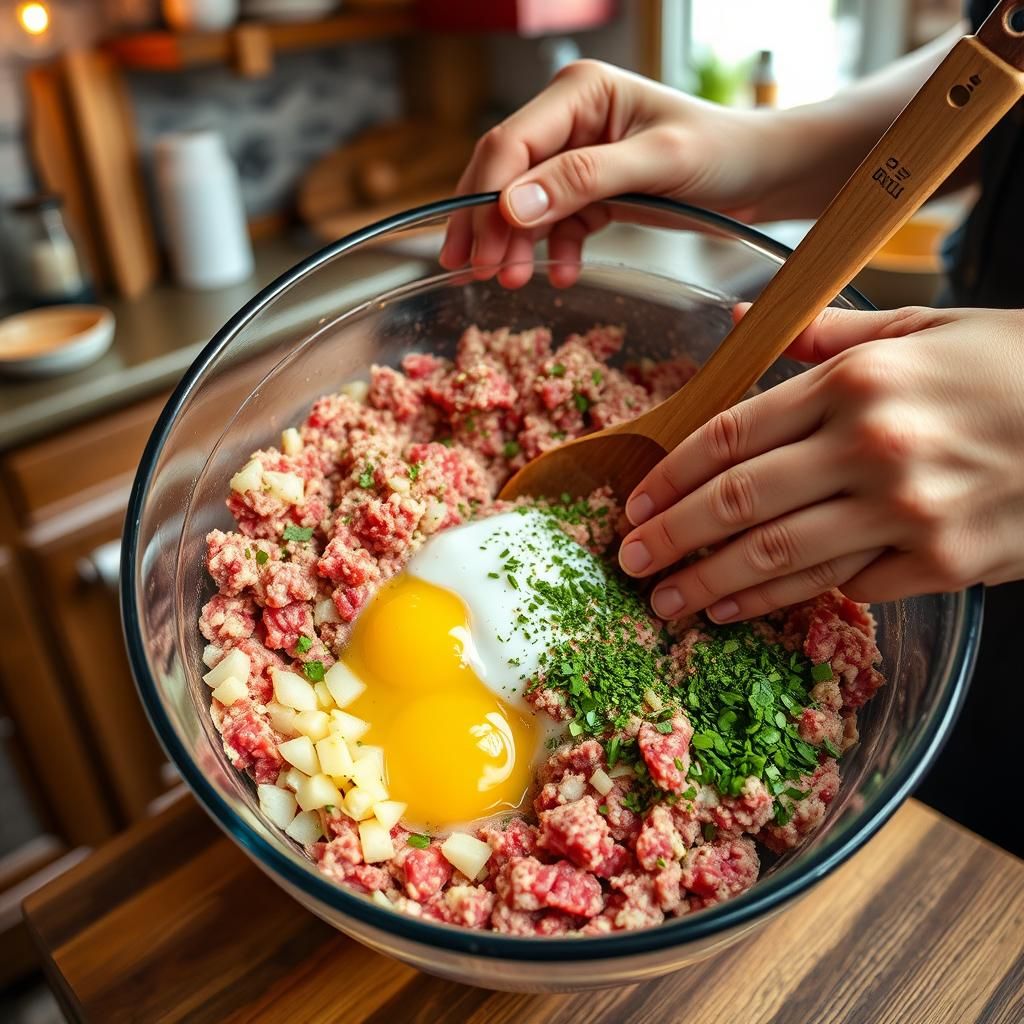
4. **Mix Gently:** Using your hands (the best tool for this!) or a large spoon, gently mix the ingredients until just combined. *Critical Step: Do not overmix!* Overmixing compacts the meat proteins, resulting in a dense, tough, and dry meatloaf. Mix only until everything is evenly distributed.5. **Form the Meatloaf:** * **Using a Loaf Pan:** Transfer the mixture to the prepared loaf pan. Gently press it evenly into the pan. Using a loaf pan helps the meatloaf retain its shape and traps some moisture, potentially leading to a moister result. * **Freeform on Baking Sheet:** If you prefer a crispier exterior or plan to drain fat easily, form the mixture into a loaf shape directly on the prepared baking sheet. Aim for an oval shape, about 8-9 inches long and 4-5 inches wide, roughly the size of a loaf pan. *Pro Tip: Shaping it slightly higher in the center can help it cook more evenly.*6. **Prepare the Glaze:** In a small bowl, whisk together the sugar-free ketchup, tomato paste, apple cider vinegar, keto granular sweetener, Dijon mustard, salt, and pepper until smooth. Taste and adjust the sweetener or vinegar if needed to suit your preference.7. **Initial Bake (Optional but Recommended):** Bake the meatloaf plain for the first 20-25 minutes. This allows it to set and develop some structure before the glaze is added.
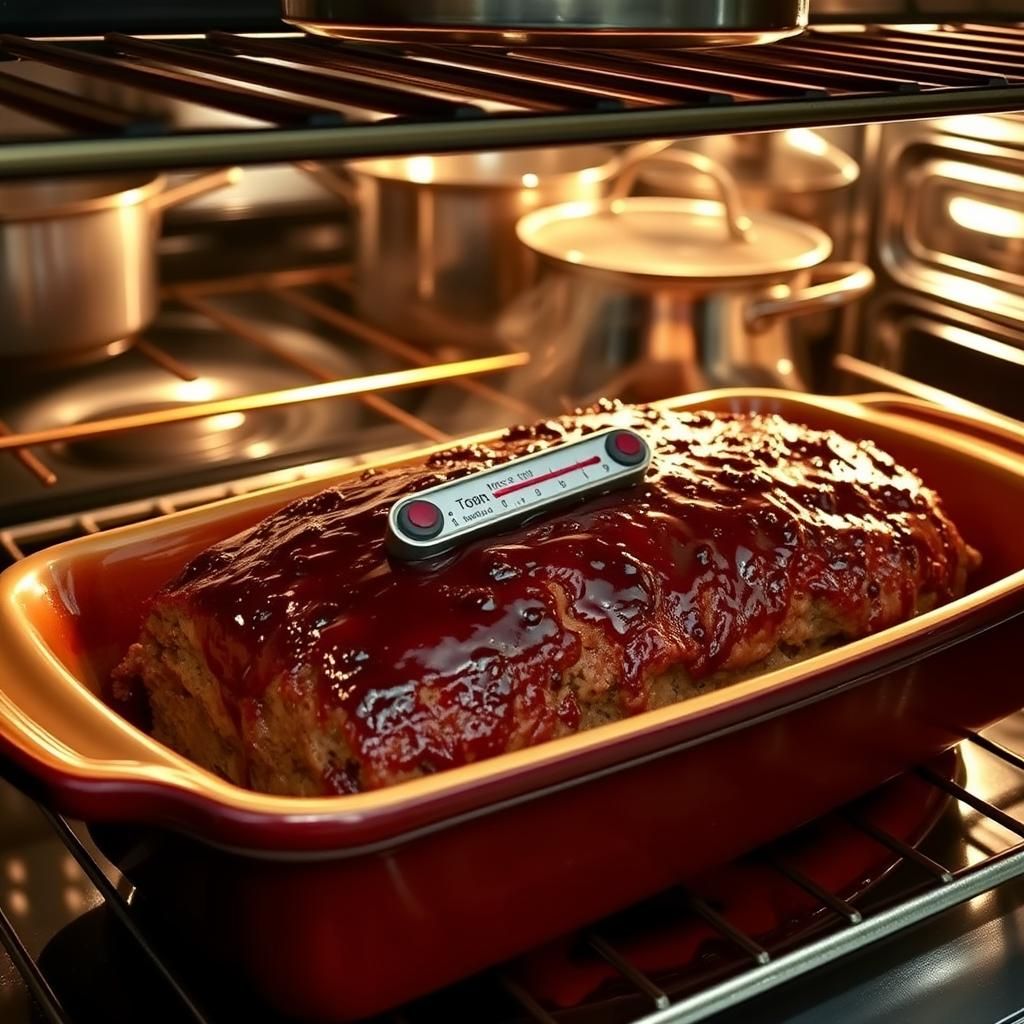
8. **Add the Glaze:** After the initial baking time (or right away if skipping step 7), spoon or spread the prepared keto glaze evenly over the top and sides of the meatloaf.9. **Continue Baking:** Return the meatloaf to the oven and continue baking for another 30-35 minutes, or until the internal temperature reaches 160°F (71°C) for ground beef. The glaze should be bubbly and slightly caramelized. *Cooking time will vary based on the thickness of your loaf and your oven.* Use an instant-read thermometer inserted into the thickest part of the loaf to ensure it’s cooked through.10. **Rest:** This is another crucial step for a moist meatloaf. Once the meatloaf reaches the target internal temperature, remove it from the oven. If using a loaf pan, you might carefully drain off excess fat *before* resting, or use the parchment overhang to lift it to a cutting board. Let the meatloaf rest for 10-15 minutes before slicing. *Pro Tip: Resting allows the juices to redistribute throughout the meat, resulting in a much moister slice.* Tent loosely with foil during resting to keep it warm.

11. **Slice and Serve:** Slice the meatloaf into portions about 1 inch thick. Serve hot with your favorite keto-friendly side dishes.Enjoy your delicious, low-carb, easy keto meatloaf!
The Secret to a Moist Keto Meatloaf
One of the most common challenges with keto meatloaf is preventing it from drying out. Without the moisture-absorbing capacity of traditional breadcrumbs, keto binders can sometimes lead to a less-than-ideal texture if not managed correctly. Here are the secrets to achieving a beautifully moist keto meatloaf:1. **Use Meat with Sufficient Fat:** As mentioned earlier, 80/20 ground beef is excellent for moisture. If using leaner meat like 90/10 beef or ground turkey/chicken, consider adding extra fat, such as: * Mixing in a few tablespoons of softened butter. * Adding a splash of heavy cream to the mixture. * Incorporating finely diced bacon or pancetta (cooked or uncooked).2. **Don’t Overmix the Meat:** This is perhaps the *most critical* tip for *any* meatloaf, traditional or keto. When you overmix ground meat, you develop the protein strands (myosin), which causes the meat to become dense, tight, and ultimately, tough and dry. Mix gently with your hands until the ingredients are *just* combined. Stop as soon as you no longer see distinct pockets of unmixed ingredients.3. **Sauté Your Aromatics:** Raw onions and garlic release moisture as they cook, which can sometimes make the surrounding meat slightly less cohesive. Sautéing them first removes excess water, softens their texture, and concentrates their flavor, leading to a better-textured meatloaf.4. **Ensure Adequate Liquid:** The addition of a liquid like broth, cream, or almond milk helps distribute moisture evenly throughout the mixture before cooking. Don’t skip this step, especially if using a drier binder like almond flour.5. **Don’t Overbake:** Overcooking is a primary culprit for dry meat. Use an instant-read thermometer and remove the meatloaf from the oven as soon as it reaches the safe internal temperature (160°F for beef, 165°F for poultry). The meatloaf will continue to cook slightly from residual heat as it rests.6. **Rest Your Meatloaf:** Allowing the meatloaf to rest for 10-15 minutes after baking is non-negotiable for moisture. During cooking, juices are pushed towards the center of the loaf. Resting allows these juices to redistribute throughout the meat. Cutting too soon lets all those precious juices run out onto the cutting board instead of staying in the meat where they belong.7. **Consider Your Binder Choice:** While all three recommended binders work, crushed pork rinds tend to result in a slightly lighter texture compared to denser flours like almond or flaxseed meal. Experiment to see which texture you prefer. Using a combination can also work well.By paying attention to these details – selecting the right meat, mixing gently, adding moisture, cooking to temperature, and resting – you can consistently produce a moist and flavorful keto meatloaf that rivals its traditional counterpart.
Keto Binder Deep Dive: Alternatives to Breadcrumbs
Let’s take a closer look at the popular low-carb binders and why they function as excellent replacements for breadcrumbs in keto meatloaf.**1. Almond Flour:*** **How it works:** Finely ground almonds absorb some of the meat juices and other liquids in the mixture, similar to breadcrumbs. It helps the loaf hold its shape and adds a subtle richness.* **Pros:** Widely available, relatively neutral in flavor, adds a bit of healthy fat and fiber.* **Cons:** Can sometimes create a slightly denser texture than pork rinds if too much is used. Needs to be finely ground for the best result.* **Usage:** Typically 1/4 cup per pound of meat, often combined with an egg.**2. Ground Flaxseed Meal:*** **How it works:** When mixed with liquid, flaxseed meal forms a gel-like consistency that acts as a powerful binder. Its high fiber content also helps absorb moisture.* **Pros:** Excellent binder, very high in fiber and omega-3 fatty acids, distinctly low in net carbs.* **Cons:** Has a more noticeable, slightly earthy/nutty flavor that might not be preferred by everyone. Can make the meatloaf quite firm if too much is used.* **Usage:** Often used in slightly smaller quantities than almond flour (e.g., 2-3 tablespoons per pound of meat), combined with an egg.**3. Crushed Pork Rinds (Pork Panko):*** **How it works:** Crushed pork rinds mimic the airy texture of breadcrumbs more closely than flours. They absorb fat and liquid while adding a savory flavor and contributing zero carbohydrates.* **Pros:** Zero carb, excellent flavor, contributes to a lighter texture, readily available (just crush plain pork rinds).* **Cons:** The flavor is distinctly savory/porky, which works well in meatloaf but is something to be aware of. Needs to be *very* finely crushed to integrate well and not leave large crunchy pieces.* **Usage:** Similar quantity to almond flour, about 1/4 cup per pound of meat, combined with an egg. Can often be used interchangeably with almond flour volume-wise.**Why is a Binder Necessary?**Even on keto, a binder is important in meatloaf for several reasons:* **Structure:** It helps the meatloaf hold its shape during mixing, forming, and cooking, preventing it from crumbling apart.* **Moisture Management:** Binders absorb excess fat and juices released by the meat as it cooks. This helps keep the loaf moist internally rather than having it sit in a pool of grease (especially important if using a fattier meat in a loaf pan).* **Texture:** They contribute to the overall texture, preventing the meatloaf from being overly dense or crumbly.While you *could* technically make a meatloaf with just meat and egg, it would likely be more crumbly, release more fat, and have a less desirable texture compared to one using a low-carb binder. For more low-carb recipes to expand your keto repertoire, check out **500 Delicious Keto Recipes Cookbook**.
Elevating Flavor: Herbs, Spices, and Add-ins
Don’t let your keto meatloaf be bland! Layering flavors is key to making it truly delicious.**Essential Seasonings:*** **Salt and Black Pepper:** Non-negotiable. Be generous, as meat can handle a fair amount of seasoning.* **Garlic Powder and Onion Powder:** These provide consistent flavor throughout the loaf, complementing the fresh onion and garlic.* **Worcestershire Sauce:** Adds umami and depth. A little goes a long way. Choose a low-sugar version if possible.* **Dijon Mustard:** Adds a tangy, slightly sharp note that cuts through the richness of the meat.**Herbs:**Fresh or dried herbs add aromatic complexity.* **Parsley:** Fresh chopped parsley adds freshness.* **Oregano:** Pungent and classic, especially with Italian seasoning blends.* **Thyme:** Earthy and savory.* **Rosemary:** Pungent and slightly piney; use sparingly as it can be strong.* **Sage:** Pairs wonderfully with pork or beef/pork mixes.* **Dried Italian Seasoning:** A convenient blend of oregano, basil, thyme, and rosemary, often with marjoram.**Spices:*** **Smoked Paprika:** Adds a subtle smoky depth.* **Cayenne Pepper or Red Pepper Flakes:** For a touch of heat.* **Mustard Powder:** Adds a clean, sharp mustard flavor without the liquid.**Optional Add-ins:**These ingredients can add extra moisture, flavor, and texture. Ensure they are finely chopped or cooked as needed.* **Finely Diced Bell Peppers:** Add sweetness and moisture. Sauté with the onions.* **Sautéed Mushrooms:** Earthy flavor and moisture. Sauté until moisture is released and evaporated.* **Finely Chopped Celery:** Adds a subtle aromatic crunch.* **Shredded Zucchini:** A great way to add moisture and hide extra veggies. Grate and squeeze out excess water before adding.* **Cooked, Crumbled Bacon:** Adds incredible smoky, salty flavor and crispy bits.* **Cheese:** Shredded cheddar, mozzarella, or Parmesan can be mixed into the loaf for added richness and flavor. About 1/2 cup per 2 lbs of meat works well.* **Finely Chopped Spinach:** Squeeze out all excess water before adding.Don’t feel obligated to add everything, but consider which flavors you enjoy and experiment to find your perfect combination. Start with the essential seasonings and herbs, then branch out with add-ins.
Keto Meatloaf Glaze Options (Beyond Ketchup)
While a sugar-free ketchup-based glaze is the easiest and most classic keto option, you have other delicious low-carb ways to top or sauce your meatloaf.**1. The Classic Sugar-Free Ketchup Glaze:*** As detailed in the recipe, this combines sugar-free ketchup, tomato paste, vinegar, and sweetener. It caramelizes slightly in the oven, giving that familiar tangy and slightly sweet crust. This is the most straightforward and popular keto glaze.**2. Sugar-Free BBQ Glaze:*** Use a high-quality, very low-carb or sugar-free BBQ sauce as the base. Many keto BBQ sauces are available commercially or can be made at home using sugar-free sweeteners.* Mix the sugar-free BBQ sauce with a little apple cider vinegar, a touch more sweetener if needed, and maybe a pinch of smoked paprika or cayenne. Brush over the meatloaf in the last 15-20 minutes of baking.**3. Tangy Mustard Glaze:*** For those who love mustard, this is a great option.* Combine equal parts Dijon mustard and sugar-free ketchup, or use Dijon mustard mixed with a little vinegar, a touch of sweetener, and perhaps some sour cream or heavy cream for richness.**4. Keto Mushroom Gravy:*** Instead of a glaze applied before baking, you can serve the meatloaf with a rich, savory mushroom gravy.* Sauté sliced mushrooms and onions in butter. Add beef broth and heavy cream. Thicken with a little xanthan gum or a small amount of unflavored protein powder whisked into cold water (make a slurry). Season with salt, pepper, thyme, and Worcestershire sauce. Simmer until thickened. Serve spooned over sliced meatloaf. If you enjoy warming soups, explore **Keto Soup Detox** recipes.**5. Creamy Onion or Garlic Sauce:*** Sauté finely diced onions or minced garlic in butter until softened. Add beef or chicken broth and heavy cream. Thicken with a keto-friendly thickener (like xanthan gum – use sparingly!). Season with salt, pepper, and maybe some chives or parsley.**6. Simple Pan Sauce:*** After the meatloaf is removed and resting, you can make a quick sauce in the pan drippings (if using a baking sheet with edges or carefully reserving drippings from a loaf pan).* Pour off most of the fat, leaving about 1-2 tablespoons. Add chopped shallots or garlic and cook briefly. Deglaze with a splash of broth or dry white wine (check carbs). Add some heavy cream or a pat of butter. Thicken slightly if desired. Season to taste.The glaze or sauce adds another layer of flavor and moisture to the finished meatloaf. The sugar-free ketchup glaze is easiest as it bakes on, while gravies and sauces are typically made separately and served alongside. Choose based on your preference and how much effort you want to put in!
Cooking Methods and Tips
While oven baking is the most common method for meatloaf, understanding a few techniques can improve your result.**Oven Baking:*** **Loaf Pan vs. Freeform:** * *Loaf Pan:* Helps maintain a consistent shape and size. Traps some fat and moisture at the bottom, which can contribute to moisture but some prefer to drain it. Cook time is predictable. * *Freeform (on baking sheet):* Allows hot air to circulate around the entire loaf, often resulting in a crispier exterior crust (especially if you use a wire rack inside the baking sheet). Excess fat can drain away easily. May cook slightly faster. Requires careful shaping to prevent spreading too much.* **Using a Rack:** Placing a wire rack inside your baking sheet or even inside the loaf pan (if it fits and the loaf is formed on top) allows hot air to circulate underneath and lets fat drip away from the meatloaf. This can help prevent the bottom from becoming soggy or greasy, especially with fattier meats or binders that don’t absorb much fat (like pork rinds).* **Temperature:** 375°F (190°C) is a standard temperature for meatloaf. It’s hot enough to cook within a reasonable time (around 50-60 minutes for a 2lb loaf) but not so hot that the outside burns before the inside is cooked. Some recipes use 350°F (175°C) for a longer, slower cook, which can also contribute to moisture, but takes longer.**Other Potential Methods (Less Common for Standard Meatloaf):*** **Air Fryer (for mini loaves):** A standard large meatloaf is too big for most air fryers. However, forming the meat mixture into smaller, individual “meatloaf muffins” or mini loaves works well in an air fryer. Cook time will be significantly reduced (perhaps 15-25 minutes depending on size and air fryer model). For more keto air fryer ideas, check out the **Keto Air Fryer Cookbook**.* **Smoking:** For the adventurous cook, meatloaf can be smoked! It adds incredible flavor. It’s typically formed freeform or in a pan and smoked at a lower temperature (around 225-250°F / 105-120°C) for a few hours, then potentially finished at a higher temperature or moved to an oven to reach the final internal temp and set the glaze.**Key Cooking Tips:*** **Use a Meat Thermometer:** This is the *most reliable* way to know when your meatloaf is done and avoid overcooking (which leads to dryness). Insert it into the thickest part, avoiding any added cheese or other pockets that could give a false reading. 160°F (71°C) for ground beef, 165°F (74°C) for ground turkey/chicken.* **Don’t Skip the Rest:** As emphasized, resting is crucial for moisture.* **Consider Draining Fat:** If using a loaf pan and a high-fat meat, there will likely be a pool of rendered fat at the bottom. You can carefully pour this off before resting or before slicing if you lifted the loaf out.* **Glaze Timing:** Adding the glaze partway through baking allows it to caramelize without burning. If you add it at the beginning, it might become too dark or hard.Mastering these cooking methods and tips will help you achieve a perfectly cooked, moist, and flavorful keto meatloaf every time.
Perfect Pairings: Keto Sides for Meatloaf
A delicious meatloaf deserves equally delicious side dishes that fit within a low-carb framework. Here are some popular and easy keto-friendly sides to complement your meatloaf:* **Mashed Cauliflower:** This is the ultimate keto replacement for mashed potatoes. Steam or boil cauliflower florets until very tender, then mash or puree with butter, heavy cream, salt, and pepper until smooth. Add garlic powder or cheese for extra flavor.* **Steamed or Roasted Green Vegetables:** * **Broccoli:** Steamed or roasted with butter and salt. * **Green Beans:** Steamed, sautéed with garlic and bacon, or roasted. * **Asparagus:** Roasted or grilled with olive oil, salt, pepper, and maybe lemon. * **Brussels Sprouts:** Roasted until crispy with bacon or Parmesan cheese. * **Spinach:** Quickly sautéed with garlic.* **Keto Gravy:** A savory gravy made from pan drippings (if available) or broth, thickened with xanthan gum or another keto thickener, and finished with cream or butter. Perfect drizzled over the meatloaf and mashed cauliflower.* **Loaded Broccoli or Cauliflower Bake:** Steam florets until just tender, then toss with cheese, cooked crumbled bacon, a dollop of sour cream, and bake until bubbly and golden.* **Creamed Spinach:** Sauté spinach and finish with heavy cream and Parmesan cheese.* **Zucchini Noodles (Zoodles):** Sautéed lightly and tossed with butter or a light sauce.* **Large Green Salad:** A simple salad with leafy greens, cucumber, tomatoes (in moderation), and a low-carb dressing.
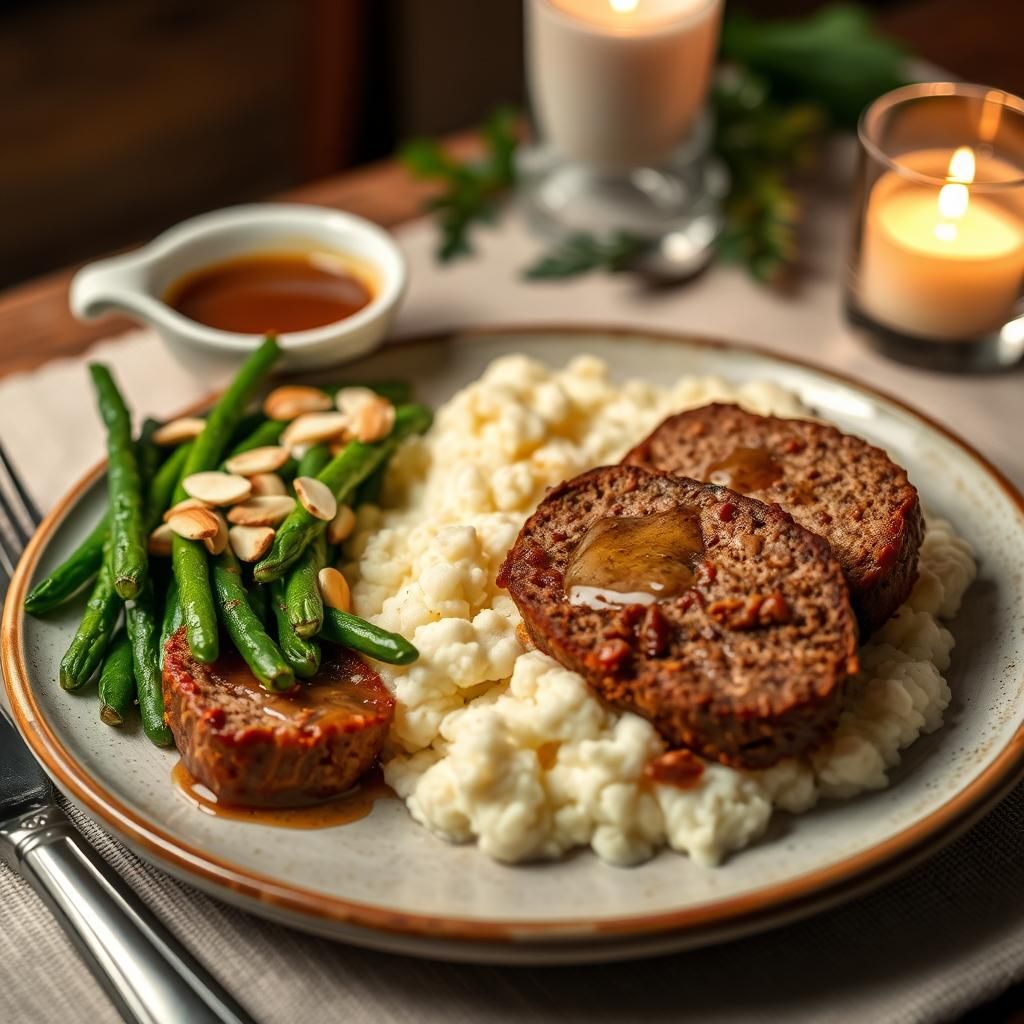
These sides provide necessary fiber, vitamins, and minerals while keeping your meal low in carbohydrates, making a complete and satisfying keto plate. Looking for other keto treats? Try the recipes in the **Keto Dessert Book** or find easy ideas in the **Keto Snack Cookbook**.
Meal Prepping and Storage
Keto meatloaf is an excellent candidate for meal preparation, providing easy and delicious meals throughout the week.

**Storage:*** **Refrigeration:** Once completely cooled, store leftover meatloaf slices or the whole loaf in an airtight container in the refrigerator for 3-4 days.* **Freezing:** Meatloaf freezes exceptionally well, either cooked or uncooked. * **Cooked:** Allow the meatloaf to cool completely. You can freeze it whole, in halves, or sliced into individual portions. Wrap tightly in plastic wrap, then in aluminum foil or place in a freezer-safe bag or container. This helps prevent freezer burn. Cooked meatloaf can be frozen for 3-4 months. * **Uncooked:** Prepare the meatloaf mixture and form the loaf (in a pan or freeform). Wrap the uncooked loaf extremely well in plastic wrap and then foil. Place in a freezer bag or container. Uncooked meatloaf can be frozen for 3-4 months. Thaw in the refrigerator overnight before baking according to the recipe instructions. You may need to add a few extra minutes to the baking time.**Reheating:*** **Individual Slices (Microwave):** Place a slice on a microwave-safe plate. Cover loosely with a damp paper towel to help retain moisture. Heat on medium power until heated through.* **Individual Slices (Oven or Toaster Oven):** Place slices in a small baking dish. You can add a splash of broth or water to the bottom of the dish and cover loosely with foil. Reheat at 300-325°F (150-160°C) for 15-20 minutes, or until heated through. This is the best method for preserving texture.* **Whole or Partial Loaf (Oven):** Place the loaf in a baking dish, add a splash of broth or water, and cover tightly with foil. Reheat at 325-350°F (160-175°C) until heated through, which could take 20-40 minutes depending on the size of the loaf. Remove foil for the last few minutes if you want to crisp up the glaze slightly.* **From Frozen (Cooked):** Thaw in the refrigerator first for best results. Reheat using one of the methods above. You can technically reheat from frozen, but it will take significantly longer and may affect the texture slightly.Having pre-cooked or prepped keto meatloaf ready to go makes healthy eating on busy days incredibly convenient.
Nutritional Information (Estimation)
Providing exact nutritional information for homemade dishes can be tricky, as it depends heavily on the specific ingredients used (fat content of meat, type of binder, amount of glaze, etc.). However, we can provide an *estimated* breakdown for a typical serving of this Easy Keto Meatloaf recipe using 80/20 ground beef, almond flour as the binder, and the sugar-free ketchup glaze.* **Yields:** 6-8 servings* **Serving Size:** Approximately 1/6 to 1/8 of the loaf**Estimated Macros Per Serving (based on 8 servings, using 80/20 beef and almond flour):*** **Calories:** Approx. 350-450 kcal (varies based on beef fat)* **Net Carbs:** Approx. 3-6 grams (varies based on binder and glaze sweetener)* **Total Carbs:** Approx. 5-8 grams* **Fiber:** Approx. 2-3 grams* **Protein:** Approx. 30-35 grams* **Fat:** Approx. 25-35 grams (varies significantly based on beef fat)**Important Notes on Nutrition:*** This is an estimate. Use a nutritional calculator with your specific ingredients for a more accurate count.* The majority of carbs come from the binder (almond flour/flaxseed meal) and the small amount of natural sugar/fiber in the ketchup/tomato paste and vegetables.* Crushed pork rinds will result in a lower net carb count compared to almond flour or flaxseed meal.* Using leaner meat will decrease fat and calorie counts but may affect moisture.* Adjusting the amount of glaze or sweetener will impact the carb count.Understanding the estimated macros helps you fit this keto meatloaf into your daily carbohydrate goals.
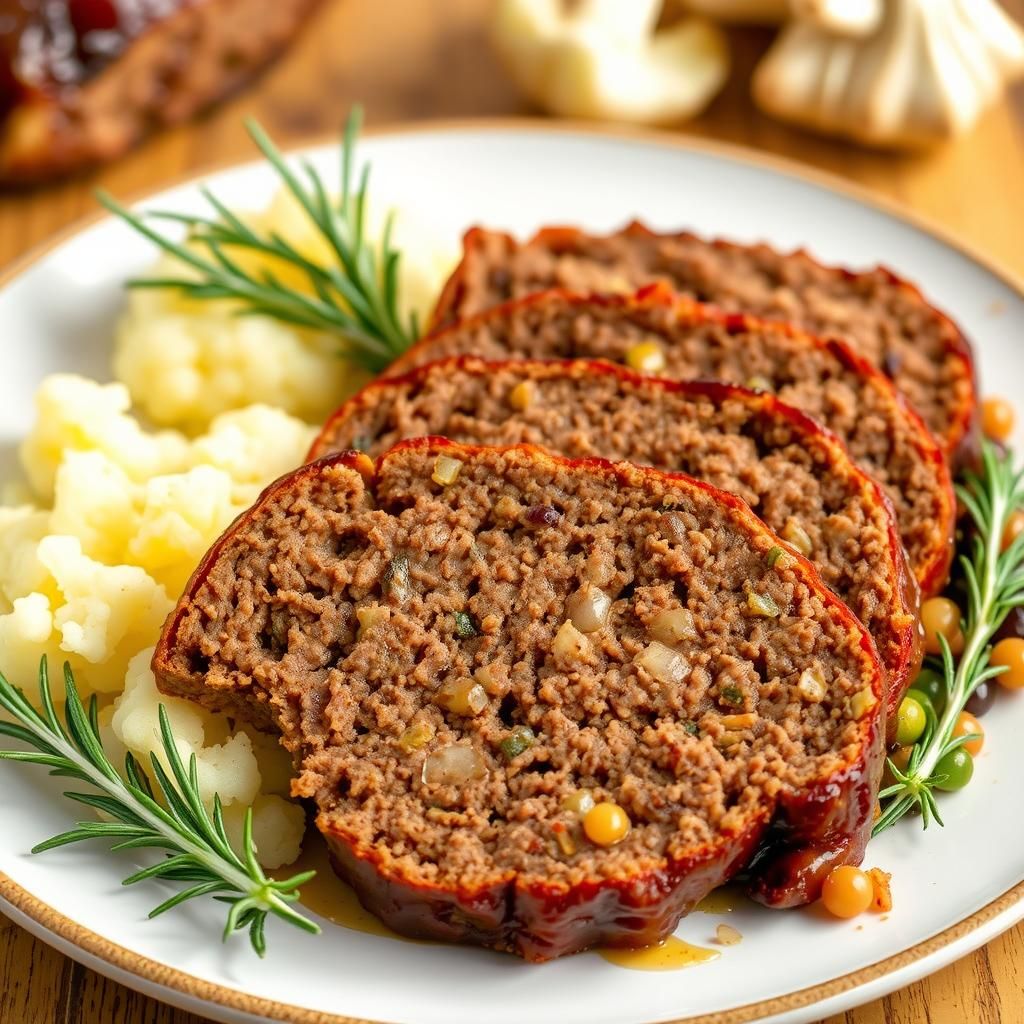
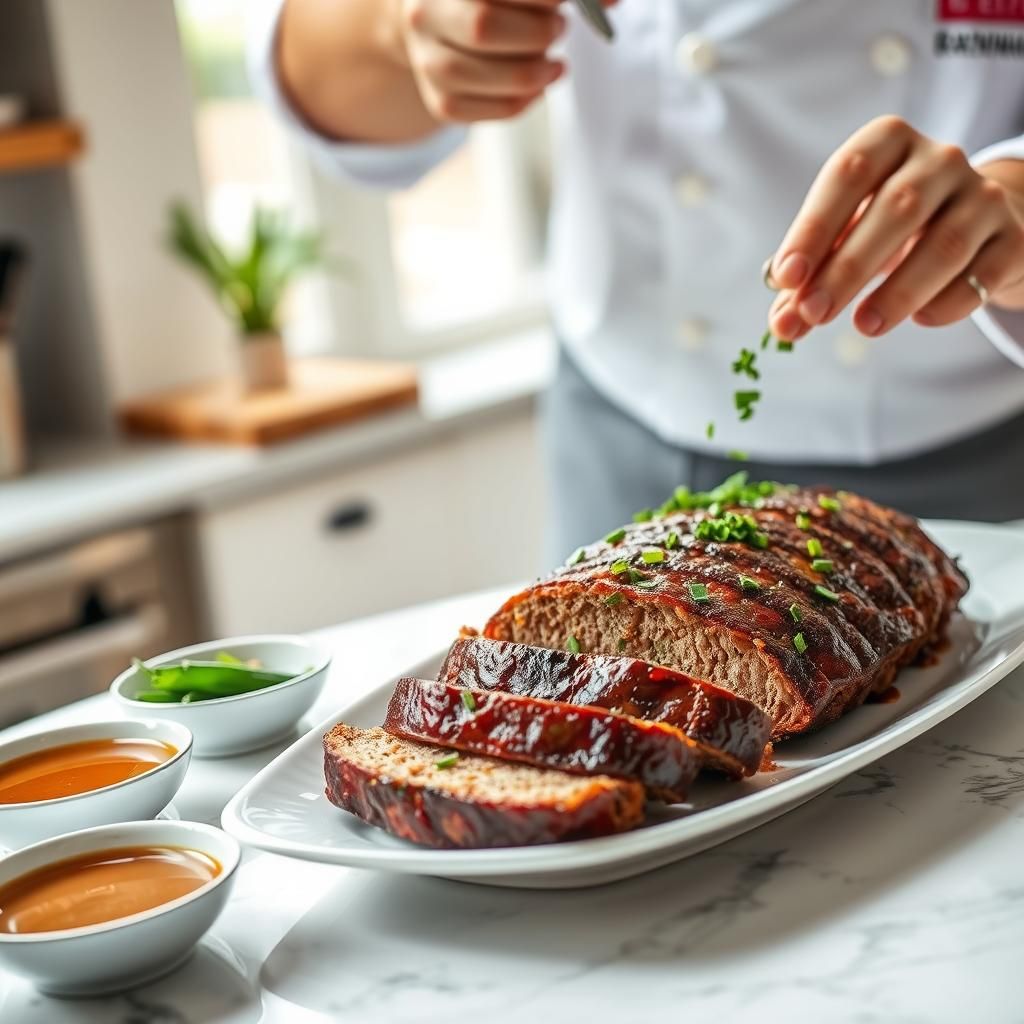
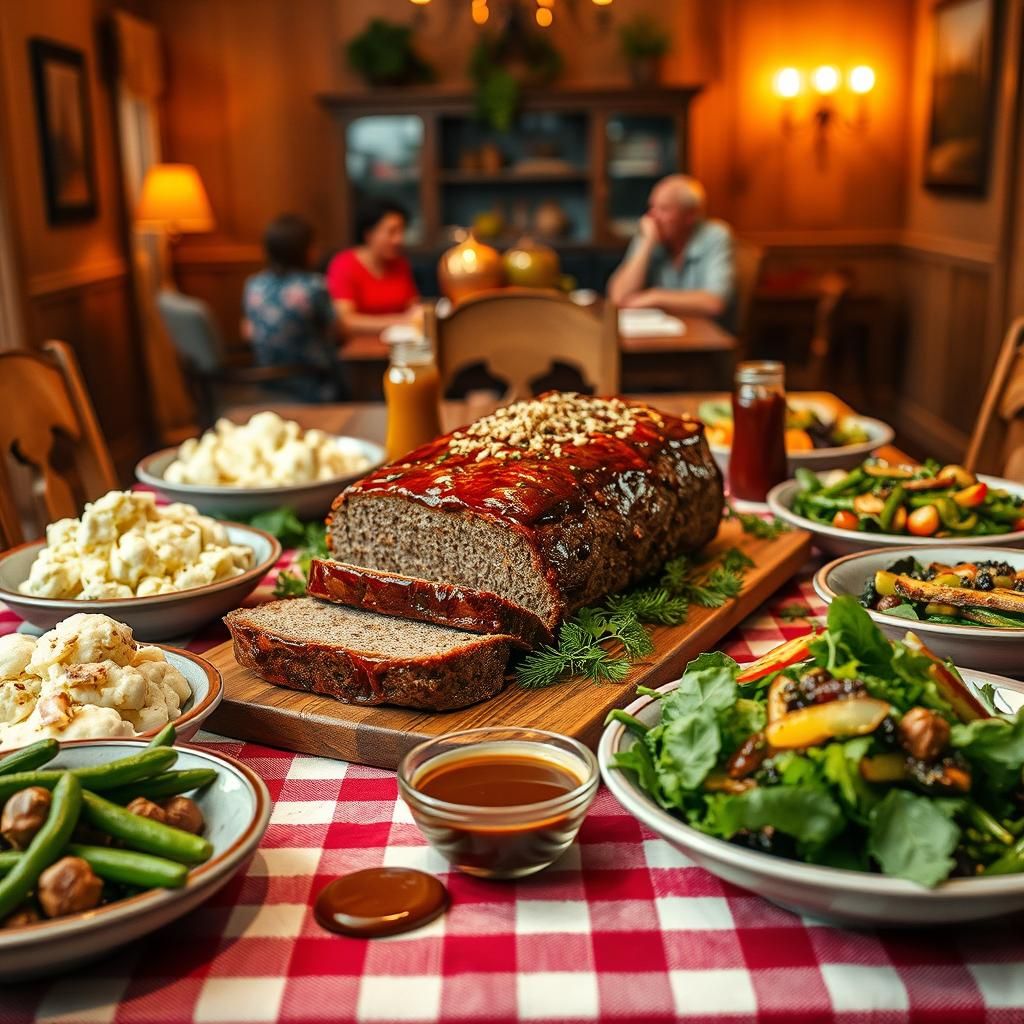
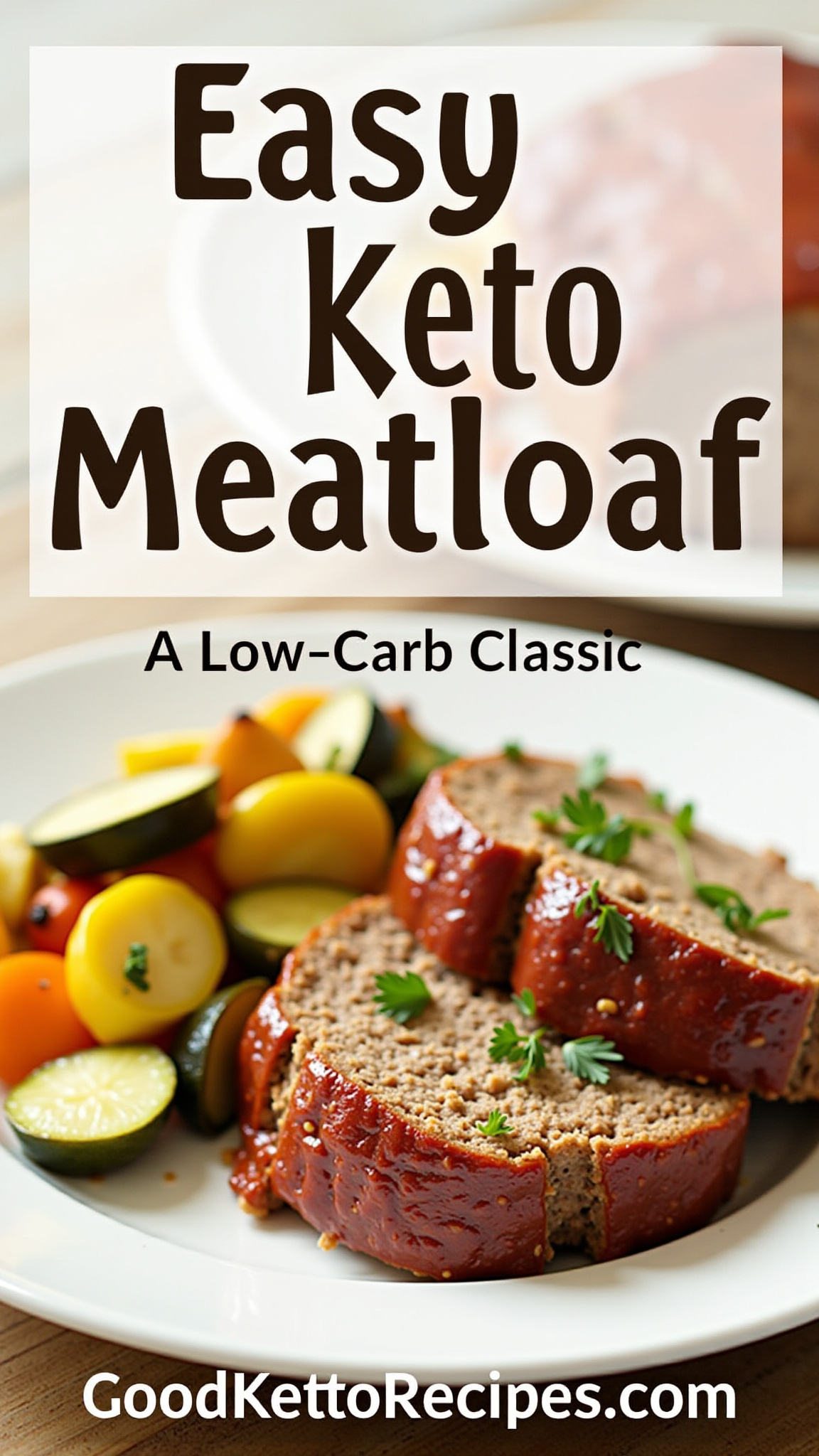
Affiliate Link Disclosure: Some of the links in this post are affiliate links. This means that if you click on the link and make a purchase, I may receive a small commission at no extra cost to you. I only recommend products or services that I personally use and believe will be valuable to my readers.
